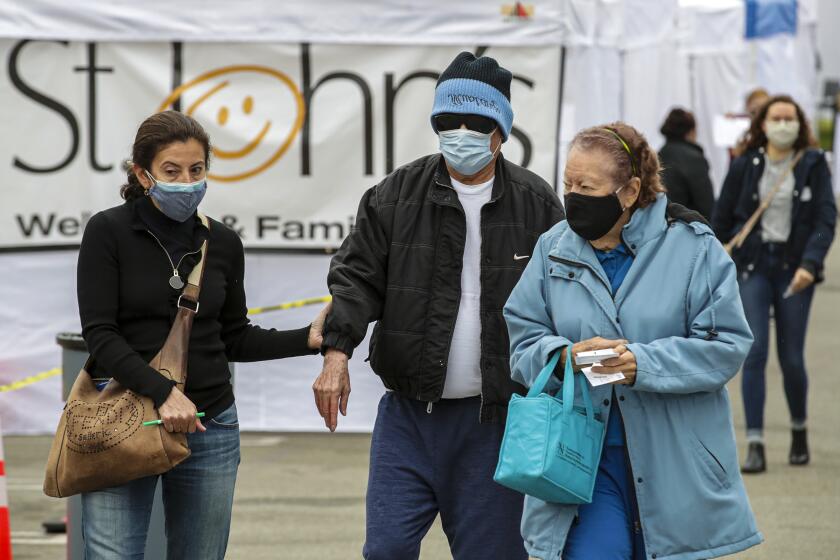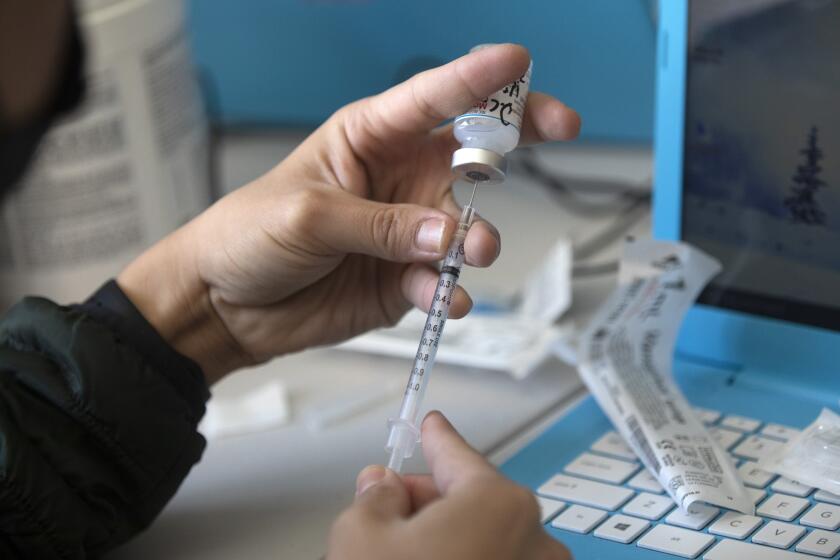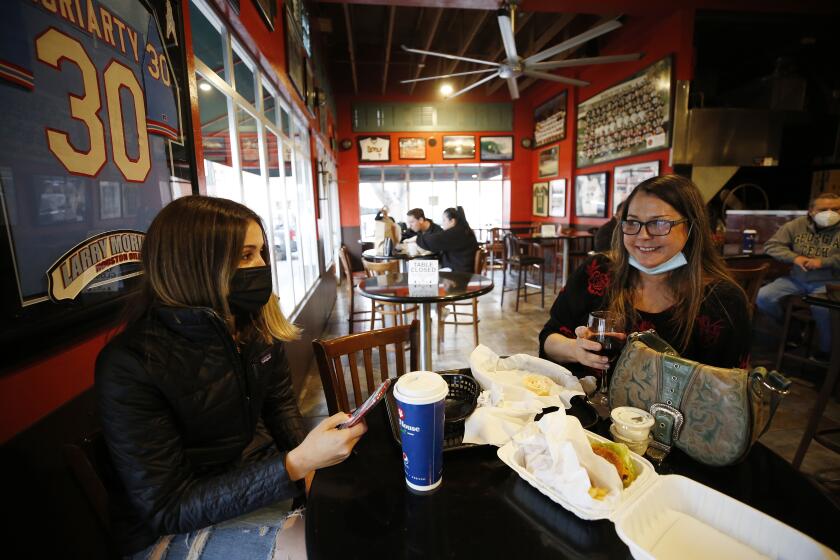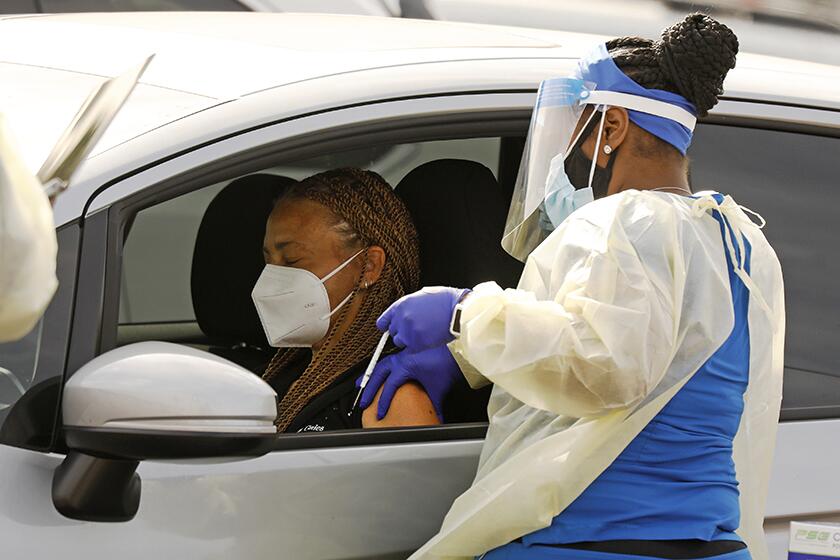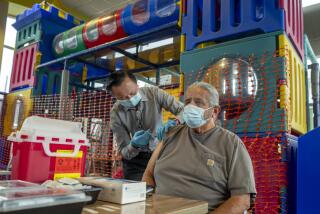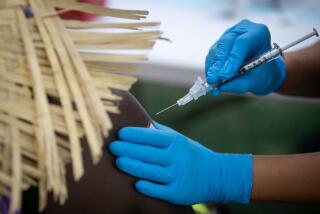L.A. County, O.C. close to wider reopening of economy as COVID-19 vaccinations climb
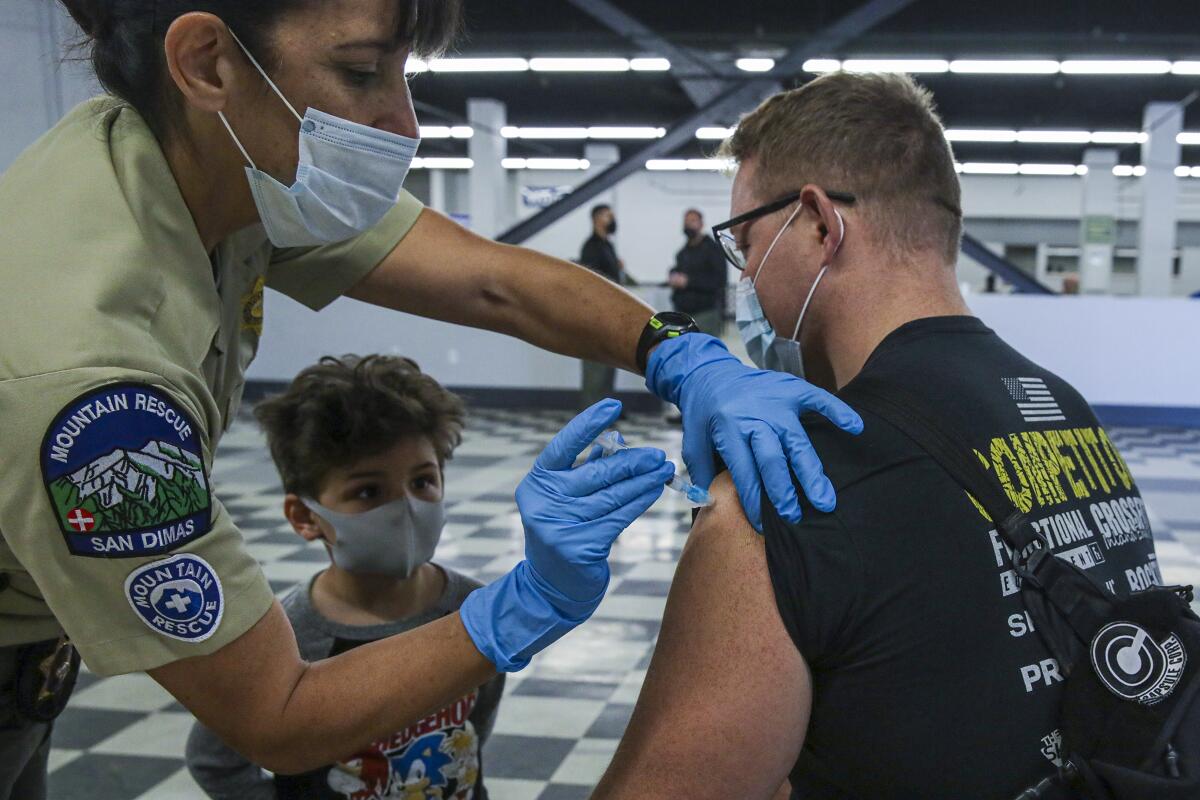
- Share via
Some of California’s largest counties — including Los Angeles — could be poised to unlock parts of their economies as soon as this week if certain state-set benchmarks are met.
The potentially accelerated opening in places like L.A., Orange and San Bernardino counties is possible thanks to a rewrite of California’s coronavirus reopening blueprint that state officials announced last week.
It works like this: 40% of the state’s available COVID-19 vaccines will now be dedicated to residents in California’s most disadvantaged areas — a massive commitment officials say will help address glaring inequities in vaccine administration.
Once 2 million doses have been administered in these communities, the state will relax the threshold required for a county to exit the most restrictive purple category of the state’s four-tier, color-coded reopening roadmap.
Under a new policy, state officials plan to reserve 40% of vaccines to underserved communities.
Currently, counties must have an adjusted daily coronavirus case rate at or below seven new cases per day per 100,000 people to move into the more permissive red tier. But after the state hits its 2-million dose goal, which it likely will do this week, counties with a case rate of up to 10 new cases per day per 100,000 people would become eligible for the red tier.
According to state data, almost 1.88 million total vaccine doses had been administered as of Monday in the targeted communities — those in the lowest quartile of the California Healthy Places index.
L.A., Orange and San Bernardino counties were among those that had logged adjusted case rates of below 10 new cases per day per 100,000 people last week. Should they fall below that threshold again when the state updates its tiering data Tuesday, it appears those counties would be allowed to progress to the next level of reopenings.
“Our understanding is that within 48 hours of the state announcing the vaccine trigger has been met, L.A. County — along with other counties with qualifying case rates — would be moved into the red tier and permitted to reopen for additional activities,” L.A. County Public Health Director Barbara Ferrer said during a briefing Monday.
County health officials are already “working with the Board of Supervisors and all of our sectors to plan for what will be a sensible and safe reopening as permitted by the state, but as appropriate for our county,” she continued.
Counties in the red tier can allow indoor restaurant dining and movie theaters to reopen at 25% capacity or up to 100 people, whichever is fewer. In-person classes also would be allowed to resume for students in grades seven through 12.
Indoor gyms and dance and yoga studios can open at 10% capacity. Museums, zoos and aquariums can open indoor activities at 25% capacity, and nonessential stores and libraries can open at 50% capacity, up from 25% capacity.
However, it’s not a given that L.A. County would immediately reopen as widely as the red tier allows. Counties can adopt rules that are stricter, but not more lenient, than the state’s.
“As we plan to move into the red tier, where additional reopenings will be permitted, we’re looking closely at the science to understand what practices can help reduce community transmission of COVID-19,” Ferrer said.
She pointed to a study by the U.S. Centers for Disease Control and Prevention, which found that the rate of COVID-19 deaths slowed in counties where states required masks, and sped up in counties where states allowed on-site restaurant dining.
“That’s something that we’ll need to take into account as we begin more reopenings in our restaurants,” she said.
Officials offered a road map that could lead to reopening — with limits — as soon as April.
While changing the red tier threshold would accelerate reopenings in some counties, others are poised to progress this week regardless. Based on the latest state data, 12 counties could potentially move ahead this week, including nine currently in the purple tier: Alameda, Butte, Calaveras, Imperial, Mono, Placer, Santa Cruz, Solano and Tuolumne.
Gov. Gavin Newsom said Monday that the state is seeing “more and more progress every day as we’re reopening our economy and reopening our schools safely for in-person public instruction.”
“The light truly is bright at the end of this tunnel,” he said during a briefing in Tulare County.
A potential wider reopening is among other positive news for L.A. County. Officials said the region is also slated to receive its largest single-week share of COVID-19 vaccines to date — a welcome, if possibly short-lived, boost that will allow tens of thousands of additional Angelenos to receive their first shot.
Swelling this week’s expected total haul of about 312,000 doses is a substantial shipment of the Johnson & Johnson vaccine, which federal drug regulators recently authorized for emergency use.
Officials are hopeful that vaccine will give California’s — and the nation’s — inoculation campaign a shot in the arm, as it entails only a single dose.
The other two vaccines cleared for use in the United States, one from Pfizer-BioNTech and the other from Moderna, require two shots, administered weeks apart.
L.A. County expects to receive 53,700 doses of the Johnson & Johnson vaccine this week.
It’s OK to have small, maskless gatherings indoors if everyone is vaccinated, but the CDC still warns against nonessential travel.
Officials in the city of Los Angeles said they anticipate administering 88,000 shots this week, and most of those — nearly 68,000 — will be first doses.
“Vaccines are our ticket to ending the pandemic, saving lives, rebuilding our communities and delivering hope for a healthier future,” Mayor Eric Garcetti said in a statement. “We still have a long way to go to safely and swiftly vaccinate as many Angelenos as possible — and a larger, steadier supply of doses this week means we can bring relief to more seniors, frontline and essential workers, and anyone eligible to receive a vaccine in our city.”
However, this week’s boon could be a blip, a least in the near term, as rollout of the Johnson & Johnson vaccine has been slowed by production issues.
“All counties benefited this week with the additional allocation of Johnson & Johnson doses, but we’re not sure whether there are going to be additional Johnson & Johnson doses for the next two weeks,” Ferrer said. “And that would have a huge impact.”
There are a number of things that could go wrong in California’s quest to put an end to the pandemic.
Supply pinches have been a persistent problem for health agencies across the country.
Newsom has said California is working to design a system that can deliver 4 million vaccines a week, though shipments have yet to come close to that level.
In L.A. County, officials say they already could offer more than 600,000 appointment slots a week, if they had enough doses.
The state is pivoting to a new vaccination program run by Blue Shield of California, with the goal of creating “more efficient distribution, speed, and equity and transparency,” according to Newsom.
However, that move has been met by resistance from counties that believe the system would not be able to properly accommodate their unique needs and diverse populations.
Blue Shield of California’s takeover of the state’s vaccine delivery system lack buy-in from counties, with none of California’s 58 counties having signed the Blue Shield contract yet.
For now, COVID-19 vaccines are available to those 65 or older, are residents of long-term care facilities such as nursing homes or who work in education and childcare, food and agriculture, healthcare, law enforcement or emergency services.
The pool of residents who can receive the shots is set to deepen considerably, though, as the state will expand eligibility to millions of people with underlying health problems and disabilities starting next week.
Over the last week, providers statewide have administered an average of 184,541 doses per day, according to data compiled by The Times.
To date, nearly 10.4 million total doses have gone into arms statewide, including more than 2.5 million in L.A. County alone.
Those numbers, while encouraging, are still well short of what’s needed to end the pandemic. As a result, officials say it remains important even for those who have been vaccinated to continue taking steps to stem coronavirus transmission — such as wearing masks in public, keeping physical distance from those they don’t live with and regularly washing their hands.
Under new guidance released Monday, the CDC said Americans can visit with others in small indoor gatherings, without masks or social distancing, once they’ve been fully inoculated.
“We’ve been through a lot this past year, and with more and more people getting vaccinated, each day we are starting to turn a corner,” CDC Director Dr. Rochelle Walensky said during a briefing. “And as more Americans are vaccinated, a growing body of evidence now tells us that there are some activities that fully vaccinated people can resume at low risk to themselves.”
Residents should also feel confident when it comes time to roll up their sleeves, regardless of which vaccine they are receiving, according to Dr. Christina Ghaly, L.A. County’s director of health services.
“While the vaccines do differ slightly, the ways in which they are the same are much greater and much more important than the ways in which they are different,” she said Monday. “They’re similar in the attribute that matters most: and that’s their ability to prevent the most serious courses of illness with COVID, and the ability to prevent death. I urge you to get a vaccine, regardless of which one it is, as soon as you are eligible.”
Times staff writers Chris Megerian and Melody Gutierrez contributed to this report.
More to Read
Sign up for Essential California
The most important California stories and recommendations in your inbox every morning.
You may occasionally receive promotional content from the Los Angeles Times.
